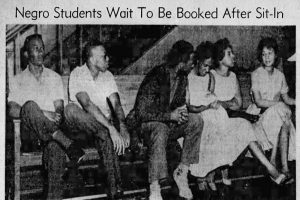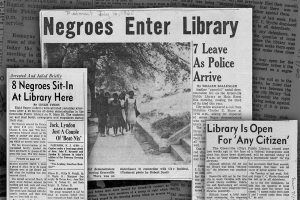
Say “civil rights sit-in,” and the mind automatically flashes to the famous peaceful protests that took place in 1960 at a Woolworth’s lunch counter in Greensboro, North Carolina. But many other antisegregation demonstrations happened before and after those protests, and many were in libraries.
August 21, 1939. Five African-American men—William “Buddy” Evans, Edward Gaddis, Morris L. Murray, Clarence “Buck” Strange, and Otis Lee Tucker—walk into the whites-only Alexandria (Va.) Library (now the Barrett branch library). Strange’s younger brother Bobby, 14, serves as lookout and courier. The men, who range in age from 18 to 22, ask for library cards and are refused. They then sit down in the library and read quietly, ignoring requests to leave, while about 300 spectators gather outside. The men are arrested and charged with disorderly conduct, but their case never comes to trial. The following year, the city builds a library branch for the sole use of “colored people” and fills it with castoff books and used furniture. Lawyer Samuel W. Tucker, who organized the sit-in, is furious with this approach. Invited to apply for a library card at the new branch, he responds in a letter: “I refuse and always will refuse.”
March 1, 1960. In Greenville, South Carolina, a group of African-American students enters the whites-only library around 4:45 p.m. They read quietly at tables for about 45 minutes before library trustees declare the library closed, more than three hours before closing time. On March 16, seven students again enter the library and are soon arrested by city police. (For the later protest on July 16, see “The Greenville Eight: The Sit-In That Integrated the Greenville Library.”)
January 9, 1962. Several black teenagers enter the Carnegie Library in Albany, Georgia, and are refused library cards. The same thing happens the next day. Later that year, the city closes the library rather than allow it to be integrated.
September 15, 1963. In Anniston, Alabama, two African-American pastors, Nimrod Quintus Reynolds and Bob McClain, ask for library cards at the town’s Carnegie Library. They are viciously beaten by a white mob but manage to escape. The next day, members of the library board accompany McClain and another black minister, George Smitherman (Reynolds was recovering from his injuries), as they go to the library and apply for library cards, this time successfully.


